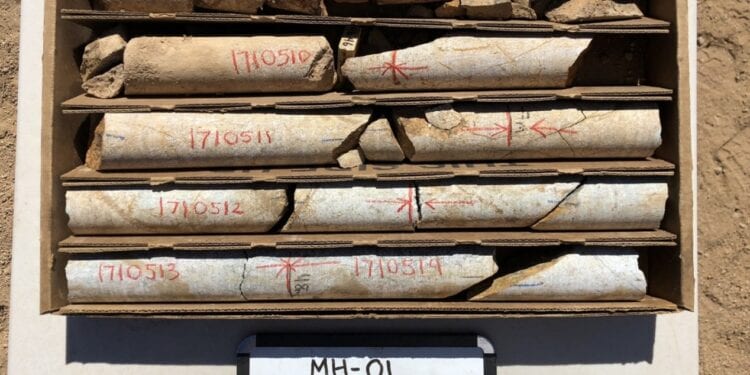Confirming Historical Arizona Mining Data
Kingman Minerals Ltd (TSXV:KGS) has intersected to historic gold and silver veins at the Mohave Project in Arizona.
The company has now completed MH-01 at a depth of 225 ft (68.6m). Core hole MH-01 was drilled to intersect the two veins that were mined primarily in the 1930s for gold and silver.
The hole was angled at -45 degrees to horizontal so that it would pass through the two veins between the 100- and 200-foot levels of the mine workings.
The intersection of the vein in two places was the objective of the drill hole and the assays have confirmed the grades of gold and silver stated in historic reports on the property.
“The high-grade intercept of gold and silver was encountered at a depth of 149.3 ft (45.5 m) with an interval length of 1.3 ft (0.4 m) (not true width). It is another significant step for the company as it suggests that there is indeed validity to the historic reports on the Project.
“As the current campaign progresses and more assays are received, we will indeed be able to speak to the veracity of the historical information more confidently; and with that, expand upon the current phase of drilling to determine the grade, size and extent of the systems that exist in Mohave,” spokesperson Brad Peek said.
Samples were sent to Skyline Laboratories in Tucson, Arizona on a rush basis and assays for gold and silver analysis were completed using Skyline’s FA-1 method for gold (Fire Assay- AA (Geochem) 5-5,000 ppb, 30g, with gravimetric finish for over-limits) and FA-8 for silver (Aqua Regia/AA (Geochem)).
The Mohave Project is located in the Music Mountains in Mohave County, Arizona and is comprised of 71 lode claims which are inclusive of the past producing Rosebud Mine.
High grade gold and silver veins were discovered in the area in the 1880’s and were mined mainly in the late 20’s and 30’s. Underground development on the Rosebud property included a 400-foot shaft and approximately 2,500 feet of drifts, raises and crosscuts.












